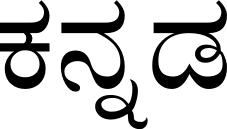Difference between revisions of "Language/Kannada/Vocabulary/Introductions"
m (Quick edit) |
m (Quick edit) |
||
| (One intermediate revision by the same user not shown) | |||
| Line 1: | Line 1: | ||
<span pgnav> | |||
{| class="wikitable pg_template_nav" | |||
|[[Language/Kannada/Vocabulary/Greetings|◀️ Greetings — Previous Lesson]] | |||
|[[Language/Kannada/Grammar/Vowels|Next Lesson — Vowels ▶️]] | |||
|} | |||
</span> | |||
{{Kannada-Page-Top}} | {{Kannada-Page-Top}} | ||
| Line 8: | Line 15: | ||
__TOC__ | __TOC__ | ||
<span link>With the completion of this lesson, consider investigating these related pages: [[Language/Kannada/Vocabulary/Food|Food]] & [[Language/Kannada/Vocabulary/Idiomatic-Expressions|Idiomatic Expressions]].</span> | |||
== Introducing Yourself == | == Introducing Yourself == | ||
| Line 90: | Line 99: | ||
[[Category:Kannada-0-to-A1-Course]] | [[Category:Kannada-0-to-A1-Course]] | ||
<span gpt></span> <span model=gpt-4></span> <span temperature=0.5></span> | <span gpt></span> <span model=gpt-4></span> <span temperature=0.5></span> | ||
==Videos== | ==Videos== | ||
| Line 105: | Line 111: | ||
<youtube>https://www.youtube.com/watch?v=N0W_eYaTsg4</youtube> | <youtube>https://www.youtube.com/watch?v=N0W_eYaTsg4</youtube> | ||
==Other Lessons== | |||
== | |||
* [[Language/Kannada/Vocabulary/Describing-People|Describing People]] | * [[Language/Kannada/Vocabulary/Describing-People|Describing People]] | ||
* [[Language/Kannada/Vocabulary/How-to-say-Good-Bye?|How to say Good Bye?]] | * [[Language/Kannada/Vocabulary/How-to-say-Good-Bye?|How to say Good Bye?]] | ||
| Line 117: | Line 122: | ||
* [[Language/Kannada/Vocabulary/Education|Education]] | * [[Language/Kannada/Vocabulary/Education|Education]] | ||
* [[Language/Kannada/Vocabulary/Telling-Time|Telling Time]] | * [[Language/Kannada/Vocabulary/Telling-Time|Telling Time]] | ||
<span class='maj'></span> | <span class='maj'></span> | ||
| Line 126: | Line 130: | ||
{{Kannada-Page-Bottom}} | {{Kannada-Page-Bottom}} | ||
<span links></span> | |||
<span pgnav> | |||
{| class="wikitable pg_template_nav" | |||
|[[Language/Kannada/Vocabulary/Greetings|◀️ Greetings — Previous Lesson]] | |||
|[[Language/Kannada/Grammar/Vowels|Next Lesson — Vowels ▶️]] | |||
|} | |||
</span> | |||
Latest revision as of 19:21, 29 March 2023
| ◀️ Greetings — Previous Lesson | Next Lesson — Vowels ▶️ |
Hello, dear students! In this lesson, we will learn how to introduce ourselves, ask someone's name, and share basic personal information in Kannada. Kannada is a beautiful language with a rich history and culture, and I am excited to help you learn and appreciate it. Let's dive into the world of Kannada introductions!
With the completion of this lesson, consider investigating these related pages: Food & Idiomatic Expressions.
Introducing Yourself[edit | edit source]
When meeting someone for the first time, it's important to introduce yourself. In Kannada, the phrase "My name is..." can be translated as "ನನ್ನ ಹೆಸರು... (Nanna hesaru...)". Let's take a look at some examples:
| Kannada | Pronunciation | English |
|---|---|---|
| ನನ್ನ ಹೆಸರು ರಾಮ್. | Nanna hesaru Rām. | My name is Ram. |
| ನನ್ನ ಹೆಸರು ಲತಾ. | Nanna hesaru Latā. | My name is Lata. |
When you want to ask someone their name, you can use the phrase "ನಿಮ್ಮ ಹೆಸರು ಏನು? (Nimma hesaru ēnu?)", which means "What is your name?". Here are some examples of how to use this phrase:
- ನಿಮ್ಮ ಹೆಸರು ಏನು? (Nimma hesaru ēnu?) - What is your name?
Now let's practice introducing ourselves and asking someone's name:
1. ನನ್ನ ಹೆಸರು ಶ್ರೀಕಾಂತ್. (Nanna hesaru Shrīkānt.) 2. ನಿಮ್ಮ ಹೆಸರು ಏನು? (Nimma hesaru ēnu?)
Sharing Basic Personal Information[edit | edit source]
After introducing yourself, you might want to share some basic personal information, such as your age, where you are from, and what you do for a living. Here are some phrases you can use:
- ನಾನು ... ವರ್ಷದವನು. (Nānu ... varṣadavanu.) - I am ... years old.
- ನಾನು ... ನಿಂದ ಬಂದಿದ್ದೇನೆ. (Nānu ... ninda bandiddēne.) - I am from ...
- ನಾನು ... ಮಾಡುತ್ತೇನೆ. (Nānu ... māḍuttēne.) - I work as a ...
Here are some examples:
| Kannada | Pronunciation | English |
|---|---|---|
| ನಾನು ೨೫ ವರ್ಷದವನು. | Nānu 25 varṣadavanu. | I am 25 years old. |
| ನಾನು ಬೆಂಗಳೂರು ನಿಂದ ಬಂದಿದ್ದೇನೆ. | Nānu Beṅgaḷūru ninda bandiddēne. | I am from Bengaluru. |
| ನಾನು ಶಿಕ್ಷಕಿ ಮಾಡುತ್ತೇನೆ. | Nānu śikṣaki māḍuttēne. | I work as a teacher. |
Now try sharing your own personal information using these phrases:
1. ನಾನು ... ವರ್ಷದವನು. (Nānu ... varṣadavanu.) 2. ನಾನು ... ನಿಂದ ಬಂದಿದ್ದೇನೆ. (Nānu ... ninda bandiddēne.) 3. ನಾನು ... ಮಾಡುತ್ತೇನೆ. (Nānu ... māḍuttēne.)
Practice[edit | edit source]
Now that we have learned how to introduce ourselves and share basic personal information, let's practice with a conversation. Try to fill in the blanks with the appropriate phrases:
A: ನಿಮ್ಮ ಹೆಸರು ಏನು? (Nimma hesaru ēnu?)
B: ನನ್ನ ಹೆಸರು .... (Nanna hesaru ....)
A: ನೀವು ಎಷ್ಟು ವರ್ಷದವರು? (Nīvu eṣṭu varṣadavaru?)
B: ನಾನು ... ವರ್ಷದವನು. (Nānu ... varṣadavanu.)
A: ನೀವು ಯಾವ ನಗರದಿಂದ ಬಂದಿದ್ದೀರಿ? (Nīvu yāva nagaradinda bandiddīri?)
B: ನಾನು ... ನಿಂದ ಬಂದಿದ್ದೇನೆ. (Nānu ... ninda bandiddēne.)
A: ನೀವು ಏನು ಮಾಡುತ್ತೀರಿ? (Nīvu ēnu māḍuttīri?)
B: ನಾನು ... ಮಾಡುತ್ತೇನೆ. (Nānu ... māḍuttēne.)
I hope you found this lesson helpful in learning how to introduce yourself and share basic personal information in Kannada. Keep practicing, and you'll become more comfortable with these phrases in no time. In the next lesson, we will learn about the Kannada alphabet and pronunciation. Until then, happy learning!
Videos[edit | edit source]
Introduction to Kannada Alphabets - Lesson 1 - YouTube[edit | edit source]
Spoken Kannada - Sample class for Self introduction and Greeting ...[edit | edit source]
Introduction to Kannada Alphabets - Lesson 2 - Vowels - YouTube[edit | edit source]
Other Lessons[edit | edit source]
- Describing People
- How to say Good Bye?
- Animals
- Days of the week (dinagalu)
- Modes of Transportation
- Adverbs
- Clothes
- Feelings and Emotions
- Education
- Telling Time
Sources[edit | edit source]
| ◀️ Greetings — Previous Lesson | Next Lesson — Vowels ▶️ |
